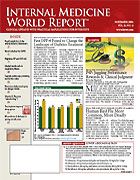under the Radar: %u201CChemical Copers%u201D an Increasing Challenge in Primary Care
Under the Radar: “Chemical Copers” an Increasing Challenge in Primary Care
By John Schieszer
PALM SPRINGS—Primary care physicians (PCPs) may want to be able to better manage patients who are overmedicating on pain medicines, now referred to as “chemical copers,” but how to do that is no simple matter. Dependence on pain medications appears to be a far more common problem than addiction to or risk for addiction to illegal drugs in the primary care setting, suggest new data presented at the recent 2005 American Academy of Pain Medicine annual meeting.
A relatively new term, “chemical copers” refers to patients who become dysfunctional as a result of overmedicating with opioids or other strong pain medications. Pain experts believe that these patients outnumber illegal drug addicts who visit primary care practices, but most physicians have not been trained in how best to identify or treat such persons.
“These patients tend to be self-medicating anxiety, depression, insomnia, or situational stress. Physicians haven’t been all that clued in on how to recognize these people,” said Steven Passik, PhD, of Memorial Sloan Kettering Cancer Center and Cornell University Medical College, NY.
Many of these patients are alexithymic and somatize their pain symptoms. Dr Eduardo Bruera, MD, of the University of Texas M.D. Anderson Cancer Center, coined the term “chemical coper” after he noticed a significant number of patients in his practice with a history of alcoholism or chemical dependency who all gave similar complaints in order to obtain opioids or other strong pain medications.
Although these patients often need psychological interventions, they rely almost entirely on pain medications, which may delay their acceptance of a life with a chronic disease or their ability to manage pain flare-ups. PCPs must recognize the problem and realize that these patients may likely be in need of treatment that would decentralize pain medications as well as rehabilitation efforts, Dr Passik observed.
“These individuals present a big problem, and they are not easy to assess in a brief interaction,” Dr Passik told IMWR. “It takes 30 seconds to write a prescription, but it takes 30 minutes to address someone’s behavior. But because of the intensity of internal medicine practice, you may need to recognize and refer out for psychotherapeutic interventions.”
Chemical copers tend not to progress after they are prescribed opioids or take their medications as prescribed. Conventional treatment of these patients has been to add a traditional, normal-release, short-acting oral opioid or to simply titrate up the dose of long-acting medications. Neither choice, however, is ideal since short-acting opioids will not act rapidly enough to relieve pain flare-ups, and increasing the dose of a long-acting opioid may result in overmedication and exacerbation of side effects.
In recent years, the introduction of rapid-acting oral opioids to control intense, short-term pain has been found beneficial but may not be a good choice for chemical copers; and published evidence is scant on how physicians can identify which of their patients is at risk for aberrant medication-taking, Dr Passik pointed out.
Studies continue to demonstrate that a significant undertreatment of chronic pain. New studies are underway that may be able to better characterize the problem of chemical coping and provide a new measurement tool, Dr Passik noted.
For now, the best approach to management is to establish goals with patients and require them to enter into a comprehensive treatment program when the problem is recognized, he said. He also recommends that physicians emphasize to patients that pain medication is only one tool for analgesia and need to show they are willing to incorporate other tools in treating any pain condition.
Scott Fishman, MD, president of the American Academy of Pain Medicine and chief, Civision of Pain Medicine, University of California, Davis, said that PCPs may be seeing several chemical copers a day without knowing it or are unsure of how best to manage them.
The single most common reason that people seek medical care in the United States is pain, he noted. It is now the second leading cause of medically related absenteeism, resulting in 50 million lost workdays annually.
“There are probably more people using medications inappropriately because of coping rather than addiction. They get stigmatized as addicts and bad patients and have their treatments discontinued rather than physicians understanding why they use the medicine and treating the underlying cause, which is often treatable,” Dr Fishman told IMWR.
